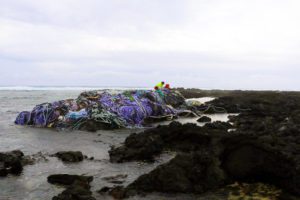
Kristen Kelly with the DLNR Division of Aquatic Resources (DAR) Protected Species Program explained, “The idea is to have people call in hazardous nets immediately. We can mount a rapid response to remove these nets from our shorelines as quickly as possible and before they drift back into the open ocean.
The hotline has a distinct Hawai‘i flavor with a bit of pidgin thrown in: 833-4-Da-Nets (833-432-6387). It is a collaboration between DAR and Sustainable Coastlines on O‘ahu; the Maui Ocean Center Marine Institute; Surfrider Foundation on Kaua‘i; and the Hawai‘i Wildlife Fund on Hawai‘i Island.
“Hawaiʻi Wildlife Fund (HWF) is happy to collaborate with this statewide marine debris hotline to recover large derelict fishing nets from along Hawaiʻi Island coastlines, as we have since 2003, thanks to grant support from the NOAA Marine Debris Program and community volunteers, said Megan Lamson, HWF Hawai‘i program director.
“Marine pollution, including abandoned, lost, and discarded fishing nets, is one of the most significant threats impacting our ocean today,” said Tommy Cutt, the Maui Ocean Center Marine Institute’s executive director. “The Marine Debris Rapid Response Hotline provides an opportunity for us to work collaboratively with our community to reduce threats facing marine life and ensure a healthy ocean for future generations.”
“Just as we share one ocean between our islands, it makes complete sense to coordinate all our efforts to respond to nets and other debris that the ocean brings in,” commented Cynthia Welti, the Chair of Surfrider Foundation Kaua‘i.
“Since 2011, Sustainable Coastlines Hawai‘i has organized and executed large-scale cleanup efforts on O’ahu and on the neighbor islands with the purpose of educating and inspiring communities to be active participants in fighting plastic pollution. Rachel Roehl of Sustainable Coastlines added, “Now, we are excited to be working with partners and the State to create means for everyone to engage and report marine debris so that our response team can effectively reduce entanglement risk and collect data on plastic pollution impacting O’ahu.”
Many of the reported and collected ghost nets will go to a second good cause…for use in a research study by Hawai‘i Pacific University’s Center for Marine Debris Research (CMDR) to try to source them back to their origin in hopes of working with fisheries to prevent them in the first place. “We rely on people to report large marine debris sightings so that we can obtain samples for this important research study. The hotline is a huge help,” said co-director of CMDR, Dr. Jennifer Lynch.
Kelly concluded, “In addition to calling the hotline, we still want to encourage folks to also report debris through the State website. You can upload photos and it ensures reporting of as much data as possible. This is especially helpful in reporting large or hazardous marine debris.
Link to the DLNR marine debris response and removal reporting form: https://dlnr.hawaii.gov/dobor/reportmarinedebrishawaii/